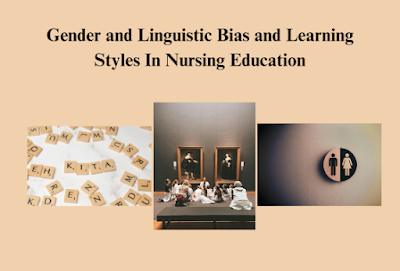The Gender and Linguistic Bias and Learning Styles In Nursing Education. In terms of bias, it is claimed that male nurses receive preferential treatment for career advancement, while female nurses receive preference for most roles and opportunities.
The Gender and Linguistic Bias and Learning Styles In Nursing Education
Gender and language biases can significantly influence learning styles and overall nursing education. Gender stereotypes can influence how students learn and how they are perceived by faculty and peers. Linguistic biases, such as the use of gender-specific terms or language that reinforces stereotypes, can also create barriers to inclusion and equitable learning.
Textbooks and other teaching materials often contain implicit gender bias and portray men and women in stereotypical roles. For example, men are portrayed as scientists, leaders, and decision-makers, while women are often portrayed in caring or domestic roles.
Learning Styles In Nursing Education In the realm of nursing education, recognizing and addressing gender and linguistic biases is crucial for fostering an inclusive and equitable learning environment. Both faculty and students bring inherent biases to the classroom, influencing interactions and academic experiences. Understanding these biases and their impact on learning styles can significantly enhance educational outcomes and support diverse student populations.
Gender and Linguistic Bias in Nursing Education
Bias, whether conscious or unconscious, affects everyone, including those in the scientific community and educational institutions. In nursing education, faculty members must actively engage in self-reflection and cultural due diligence to mitigate their biases and understand their students’ diverse perspectives. This process is essential for creating an inclusive learning atmosphere.
Unconscious Bias and Its Impact
Unconscious bias can influence how faculty and students perceive and interact with one another. For instance, research has shown that gender bias can affect teacher-student interactions, with teachers often engaging more with one gender over another. Studies reveal that in classrooms with predominantly majority students, teachers may interact more frequently with white male students compared to women or students of color (Salter, 2004). This discrepancy underscores the need for deliberate efforts to ensure equal engagement with all students.
To address unconscious biases, faculty can use assessment tools designed to reveal personal biases in a constructive and safe manner. These tools can serve as a springboard for greater self-awareness and more equitable teaching practices. It is also crucial to be aware of how stereotypes and biases, as identified by psychologist Claude Steele (2010), can adversely affect students’ academic performance and participation.
Strategies for Addressing Bias
Implementing strategies to counteract bias is vital. For example, faculty should strive to engage all students, including quieter individuals, by creating opportunities for anonymous feedback, such as using index cards for questions and comments. This approach allows students to express their concerns without fear of judgment.
Furthermore, gender-neutral language should be employed to prevent reinforcing stereotypes. Faculty should also be aware of biases towards students who are culturally and linguistically diverse (CALD). Language differences can lead to discrimination and feelings of being undervalued among English Language Learner (ELL) students (Smith & Smyer, 2015). Faculty can support ELL students by providing resources and strategies to improve their linguistic competence, such as offering study guides, accepting drafts, and using open-ended questioning techniques.
Supporting CALD Students
To support CALD students, faculty can create a supportive environment by addressing affective issues related to language barriers. Encouraging informal conversations outside the classroom and organizing support gatherings can help students feel more included and confident in their academic abilities (Stokes, 2003). Additionally, understanding different cultural norms regarding voice registers and communication styles can enhance interactions and reduce misunderstandings (Payne, 2005; Joos, 1967).
Learning Styles in Nursing Education
Learning styles are another critical aspect of nursing education, with evidence suggesting that these styles may vary based on race and ethnicity. For instance, research using the Kolb Learning Style Inventory indicates that different racial and ethnic groups may have distinct learning preferences: African American students often align with the “assimilator” style, white students with the “converger,” Hispanic and Latino students with the “accommodator,” and Asian American students with the “diverger” (Fogg et al., 2013).
Adapting to Diverse Learning Styles
Recognizing these differences can help faculty tailor their teaching methods to better support all students. Since learning styles are not static, faculty should assist students in identifying and adapting their learning preferences throughout their nursing education (Kyprianidou et al., 2012). Additionally, students from high-context cultures—such as those from American Indian, Asian, or Latin American backgrounds—may require more background information and context in their learning activities (Giddens, 2008). Conversely, students from low-context cultures may benefit from more direct and detailed communication.
Promoting Effective Learning
Faculty should be mindful of varying preferences for studying alone versus in groups and the hierarchical perspectives some students may bring to the classroom. For example, students from cultures with a strong emphasis on authority may expect faculty to provide all necessary knowledge and may be less inclined to engage in group activities or question authority (Amaro et al., 2006). Understanding these differences can help faculty design more effective and inclusive learning experiences, avoiding the formation of cliques and ensuring that all students feel valued and engaged.
In conclusion, addressing gender and linguistic biases while accommodating diverse learning styles are essential for creating an equitable and effective nursing education environment. By actively reflecting on biases, adapting teaching strategies, and supporting CALD students, faculty can enhance the educational experience and foster a more inclusive atmosphere for all learners.
Read More:
https://nurseseducator.com/didactic-and-dialectic-teaching-rationale-for-team-based-learning/
https://nurseseducator.com/high-fidelity-simulation-use-in-nursing-education/
First NCLEX Exam Center In Pakistan From Lahore (Mall of Lahore) to the Global Nursing
Categories of Journals: W, X, Y and Z Category Journal In Nursing Education
AI in Healthcare Content Creation: A Double-Edged Sword and Scary
Social Links:
https://www.facebook.com/nurseseducator/
https://www.instagram.com/nurseseducator/
https://www.pinterest.com/NursesEducator/
https://www.linkedin.com/in/nurseseducator/
https://www.researchgate.net/profile/Afza-Lal-Din
https://scholar.google.com/citations?hl=en&user=F0XY9vQAAAAJ

I’m really inspired along with your writing abilities and also with the format for your blog. Is this a paid subject or did you modify it your self? Anyway keep up the nice quality writing, it’s rare to peer a nice blog like this one nowadays!